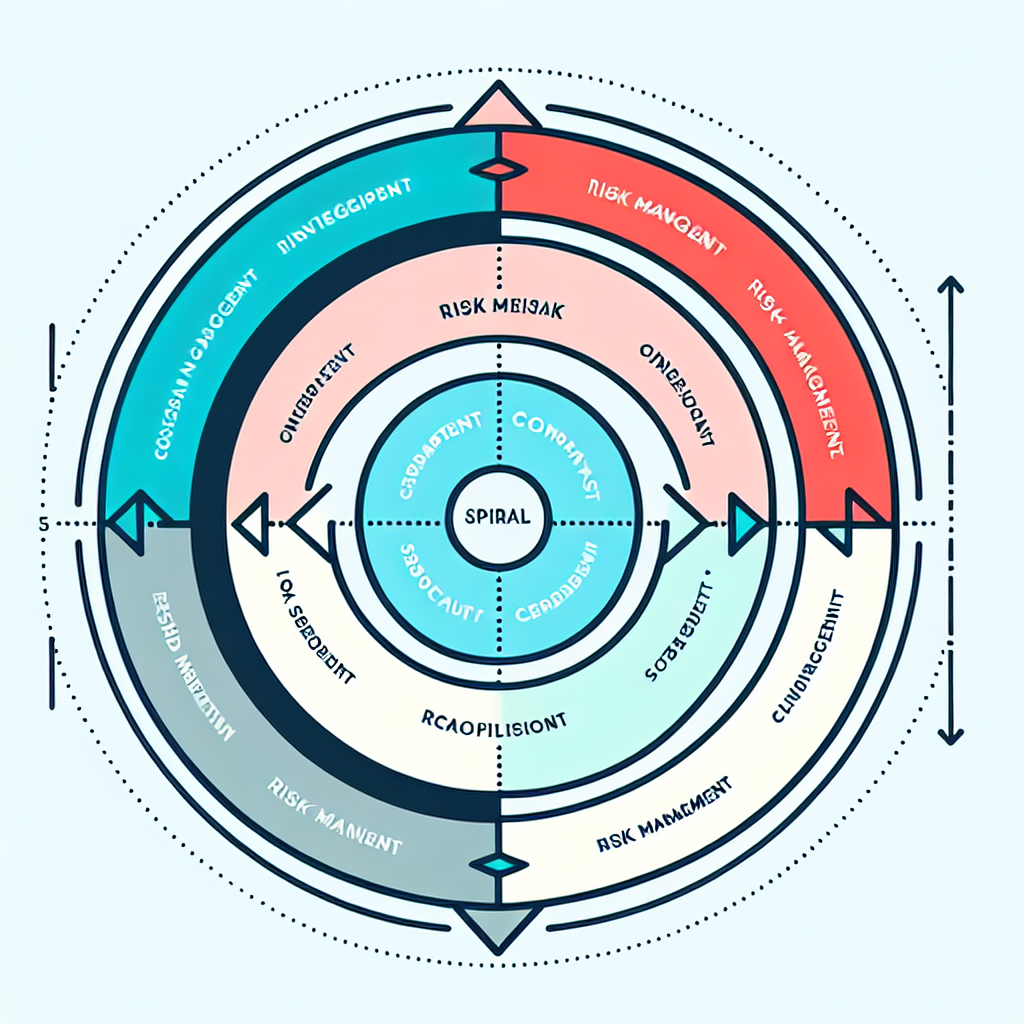The Spiral Model in software engineering is an iterative development approachdesigned to manage risks effectively.Unlike linear models, it uses cycles to reassess and address project challengescontinually. This makes it ideal for complex, high-stakes projects whererequirements can evolve. In this article, we’ll break down the phases of theSpiral Model, its core principles, advantages, and use cases, along with how itstacks up against other methodologies.KEY TAKEAWAYS * The Spiral Model prioritizes risk management and iterative development, making it ideal for complex projects with evolving requirements. * Its four main phases—Planning, Risk Analysis, Engineering, and Evaluation—facilitate continuous refinement and alignment with stakeholder expectations. * While resource-intensive and complex in management, the Spiral Model’s flexibility and emphasis on client feedback enhance project outcomes, particularly in high-risk industries.UNDERSTANDING THE SPIRAL MODELThe Spiral Model is a distinctive approach in software development, primarily employed for its robust riskmanagement capabilities. Unlike traditional models that follow a linear path,the Spiral Model’s risk-driven nature focuses on anticipating and managingchallenges at every stage of development. This iterative development processmodel is particularly valuable for complex projects where the stakes are highand the requirements may evolve.A visual representation of the Spiral Model is crucial for grasping its cyclicalnature. Each loop in the spiral signifies an iteration of the entire developmentprocess, helping teams visualize the project stages, associated risks, and thecontinuous reassessment of requirements. This diagrammatic approach underscoresthe model’s emphasis on iterative cycles, where each iteration builds on thefeedback and insights gained from previous cycles.The Spiral Model combines elements of the iterative model and the systematicWaterfall model, allowing for iterative development while maintaining astructured approach. This hybrid nature enables teams to refine the projectcontinuously, minimizing risks and enhancing project features based on prioriterations. As teams move through the spiral, their focus remains on managingrisks effectively, refining the project’s features, and ensuring alignment withstakeholder expectations.In essence, the Spiral Model’s systematic and iterative nature addresses thetriple constraints of time, cost, and scope, making it a powerful tool in thesoftware development arsenal. Its emphasis onstakeholder involvement and risk management sets it apart from othermethodologies, guiding teams through complex projects with a clear focus ondelivering high-quality software.ORIGIN AND DEFINITIONIntroduced by Barry Boehm in 1986, the Spiral Model marked a significantevolution in software development methodologies. Boehm’s pioneering work shifted thefocus towards iterative development and risk management, addressing thelimitations of earlier linear models. The introduction of the Spiral Model was agame-changer, providing a structured yet flexible framework that couldaccommodate the complexities of modern software projects.Defined as a risk-driven approach, the Spiral Model combines iterativedevelopment with systematic risk analysis, ensuring the challenges areidentified and managed early in the process. This definition underscores themodel’s primary goal: to support risk handling throughout the development lifecycle , providing a robustmechanism for navigating the uncertainties inherent in software projects.CORE PRINCIPLESAt the heart of the Spiral Model are its core principles, which revolve around arisk-driven approach and iterative development. Focusing on early identificationand addressing potential challenges, the Spiral Model manages risks proactivelyinstead of reactively. This enables continuous improvement and refinement,making the model adaptable to changing requirements.Another critical feature of the Spiral Model is its capacity to handle unknownrisks. This flexibility enables teams to manage changes effectively, ensuringthat the project can pivot as necessary to address new information or shiftingpriorities. These core principles make the Spiral Model a versatile and powerfultool in the software development process .PHASES OF THE SPIRAL MODELThe structure of the Spiral Model consists of four main phases. These arePlanning, Risk Analysis, Engineering, and Evaluation. These phases are repeatedin cycles, known as spirals, each building on the previous iteration to refineand improve the software product.Within each cycle, the phases are organized into quadrants, coveringrequirements, risk analysis, prototype building, and performance evaluation. Theiterative approach ensures a flexible, responsive development process thatsystematically addresses risks and refines project features.PLANNING PHASEThe planning phase is crucial for laying the groundwork for the entire project.During this initial phase, the project’s objectives, scope, and constraints aredefined, providing a clear direction for subsequent iterations. This involvesgathering business requirements to create a baseline for future developmentcycles, ensuring that the project aligns with stakeholder needs andexpectations.Effective project management plays a vital role in coordinating the variousphases of the Spiral Model. Project managers must ensure that the goals andobjectives are articulated and that the project stays on track throughout itslifecycle.This foundational planning phase sets the stage for a successful softwaredevelopment project , guiding thedevelopment team through each iteration.RISK ANALYSIS PHASEThe risk analysis phase is a cornerstone of the Spiral Model, emphasizing theproactive identification and mitigation of potential risks. This phase involvesqualitative and quantitative risk assessments, focusing on technical, financial,and operational risks that could impact the project. By identifying these risksearly, teams can develop mitigation strategies that prevent potential pitfallsand ensure smoother project progression.Skilled risk assessment is essential for the effective implementation of theSpiral Model. Teams must be proficient in identifying risk factors anddeveloping strategies to address them, ensuring the project can adapt to newchallenges. Continuous risk assessment maintains project stability and helpsachieve desired outcomes.ENGINEERING PHASEDuring the engineering phase, the software is developed and tested. This is thestage where the actual work happens. This phase employs a mini-Waterfallapproach for design, coding, and testing, ensuring that each software componentmeets the specified objectives. Prototyping is a key activity in this phase,turning proposals into usable software that can be tested and refined.The iterative refinement of the software product is a hallmark of the SpiralModel. Continuous development and testing of prototypes ensure the softwareevolves to meet project requirements and stakeholder expectations. This approachenhances the quality and reliability of the final software product.EVALUATION PHASEThe evaluation phase is where client feedback is collected and analyzed toinform future iterations. This phase is critical for ensuring the softwaredevelopment process aligns with customer expectations and requirements. Testresults from the engineering phase are reviewed to identify successes and areasfor improvement, guiding the next development cycle.User feedback is integrated early and often, allowing the project team toreassess goals, identify new risks, and adjust the project scope as needed. Thisiterative approach ensures that the software product continuously evolves inresponse to client input, ultimately delivering a solution that meets or exceedsexpectations.ADVANTAGES OF THE SPIRAL MODELThe Spiral Model provides several important benefits. As a result, it is acompelling option for intricate software development endeavors. Its iterativenature allows for progressive refinement of the software product, accommodatingchanges and new requirements throughout the development process. Thisflexibility makes the Spiral Model particularly suitable for projects withevolving requirements.One of the most compelling advantages of the Spiral Model is its robust riskmanagement capabilities. Prioritizing risk management and continuous riskassessment ensures potential issues are identified and mitigated early in thedevelopment process. This proactive approach to risk management enhances theoverall stability and success of the project.ENHANCED RISK MANAGEMENTEnhanced risk management is a key strength of the Spiral Model. Assessing risksat each step of the project lifecycle ensures potential challenges areidentified and addressed proactively. This continuous focus on risk managementhelps prevent potential pitfalls and ensures adherence to project objectives.The Spiral Model’s iterative nature allows for comprehensive risk assessments,which can drive up overall project costs but result in better risk managementand more predictable project outcomes. This proactive approach to riskmanagement is particularly beneficial for high-risk projects, where earlyidentification and mitigation of risks can significantly enhance projectsuccess.FLEXIBILITY AND ADAPTABILITYThe spiral model’s design permits the incorporation of changes and newrequirements during the development process, making it highly flexible andadaptable. This continuous refinement based on user feedback ensures that thefinal product aligns closely with client expectations and market demands.The model’s flexibility is particularly advantageous for software projectsdeveloped for rapidly changing markets, where requirements may shift frequently.Allowing adjustments at various stages keeps the development process responsiveto changes, enhancing customer satisfaction and delivering high-qualitysoftware.CONTINUOUS CLIENT FEEDBACKContinuous client feedback is integral to the Spiral Model, as it ensures thatthe development process remains aligned with client needs and expectations.Actively seeking feedback at the end of each iteration encourages transparencyand fosters trust among stakeholders.Regular updates and feedback loops enable development teams to capture userinput, reassess objectives, and adjust the project scope. This iterativeapproach enhances communication between team members and stakeholders, ensuringthe final product delivers high-quality software that meets or exceeds clientexpectations.DISADVANTAGES OF THE SPIRAL MODELWhile the Spiral Model offers numerous advantages, it also has its limitations.One of the main criticisms is that it is resource-intensive, requiringsignificant investments of time, money, and personnel. Each iteration involvescomprehensive planning, risk analysis, engineering, and evaluation, which candrive up overall project costs.Another challenge associated with the Spiral Model is the complexity ofmanagement. The model’s dependency on detailed risk analysis and continuousiteration can make it difficult to manage effectively, especially for large andcomplex projects. Strong project management skills are crucial for navigatingthese complexities and ensuring successful project outcomes.RESOURCE INTENSIVEThe Spiral Model’s iterative nature requires continuous investment indevelopment, which can lead to increased costs compared to other models. Eachiteration demands additional resources for planning, risk analysis, engineering,and evaluation, making the model resource-intensive.Effective resource allocation is crucial for managing the dynamic phases of theSpiral Model, as projects can encounter frequent scope changes and delayswithout proper resource management. Additionally, this can lead to customercomplaints stemming from inadequate risk management.COMPLEXITY IN MANAGEMENTManaging projects using the Spiral Model can be inherently more complex thanlinear models like the Waterfall Model. This complexity arises from the need fordetailed tracking of iteration progress, comprehensive documentation of risksand feedback, and continuous stakeholder engagement. Project managers mustpossess strong skills to navigate these dynamic phases effectively.Engaging with stakeholders at each iteration is crucial for the successfulimplementation of the Spiral Model. This continuous interaction ensuresalignment with client expectations and objectives but adds a layer of complexitythat can be challenging to manage without experienced project managers.OPTIMAL USE CASES FOR THE SPIRAL MODELThe Spiral Model is especially beneficial for specific types of projects. It isparticularly effective for those who are large, complex, or high-risk. Itsiterative and risk-driven nature makes it an ideal choice for softwaredevelopment projects that require flexibility and adaptability.LARGE AND COMPLEX PROJECTSThe Spiral Model excels in managing large and complex projects due to itsiterative nature and focus on continuous refinement. Industries such as gaming,healthcare, and telecommunications have found the model beneficial for managingthe intricacies of large-scale software development projects, ensuringreliability and adaptability.Combining the Spiral Model with methodologies like DevOps enhances continuousintegration and delivery, maintaining effective risk management while adaptingto new requirements and market changes. This hybrid approach ensures that eventhe most complex projects can be managed effectively.HIGH-RISK PROJECTSThe Spiral Model is particularly effective for high-risk projects due to itsfocus on risk management and early identification of potential issues.Conducting iterative risk assessments allows teams to address uncertainties asthey arise, keeping the project on track despite potential challenges.Industries such as software development and medical device manufacturingcommonly use the Spiral Model to manage the complexities and high risksassociated with their projects. Even small projects with significantuncertainties can benefit from the Spiral Model’s adaptability.PROJECTS WITH EVOLVING REQUIREMENTSProjects with evolving requirements are well-suited for the Spiral Model due toits risk-driven approach and continuous refinement capabilities. This modelallows for ongoing stakeholder feedback and adjustments, ensuring the projectcan pivot as necessary to meet changing needs.In rapidly changing markets, the Spiral Model provides flexibility, enablingteams to respond swiftly to new information and market dynamics. This ensuresthat the final software product aligns with current requirements andexpectations.SPIRAL MODEL VS. OTHER SDLC APPROACHESComparing the Spiral Model to other software development life cycle (SDLC)approaches helps highlight its unique strengths and potential drawbacks.SPIRAL MODEL VS. WATERFALL MODELThe Spiral Model is iterative and flexible, whereas the Waterfall Model is rigidand linear. The Waterfall Model follows a strict sequence of phases, making itless accommodating to changes once a phase is completed. In contrast, the SpiralModel’s iterative cycles allow for adjustments and refinements at any stage ofdevelopment.This flexibility makes the Spiral Model more suitable for complex softwaredevelopment projects with evolving requirements. The Waterfall Model’ssimplicity and straightforward approach can benefit smaller, well-definedprojects.SPIRAL MODEL VS. AGILE METHODOLOGYBoth the Spiral Model and Agile methodologies emphasize customer collaborationand iterative development. However, Agile focuses more on delivering functionalsoftware quickly through incremental development, while the Spiral Modelintegrates Agile principles specifically for risk management.Agile methodologies are generally faster and more suited for projects whererapid delivery is crucial, whereas the Spiral Model’s emphasis on riskmanagement makes it ideal for high-risk projects.INTEGRATING SPIRAL WITH OTHER METHODOLOGIESThe Spiral Model can be effectively combined with other developmentmethodologies, such as Agile or DevOps, to leverage their strengths. Integratingthese methodologies allows teams to benefit from the Spiral Model’s structuredrisk management while taking advantage of Agile’s speed and flexibility.This hybrid approach enhances project outcomes by ensuring robust riskmanagement, continuous integration, and rapid delivery, making it a powerfulstrategy for software development.REAL-WORLD APPLICATIONS OF THE SPIRAL MODELThe Spiral Model has proven its effectiveness in real-world applications,particularly in industries that deal with complex and high-risk projects.CASE STUDY: SOFTWARE DEVELOPMENT PROJECTA notable example is a project led by John, focusing on developing a newe-commerce platform using the Spiral Model. During the engineering phase,prototypes were developed and tested to meet project specifications, allowingfor continuous refinement based on client feedback.This iterative approach ensured the final software product aligned with theclient’s needs and market demands, demonstrating the Spiral Model’seffectiveness in delivering high-quality software in complex projects.INDUSTRY APPLICATIONSIndustries such as healthcare and aerospace commonly utilize the Spiral Modeldue to its strong focus on managing risks. These sectors often deal withsignificant technical challenges and require a robust framework for handlingevolving requirements.The Spiral Model’s iterative approach and emphasis on risk management make itparticularly suitable for enterprise-level applications that require extensiveintegration with existing systems. This adaptability ensures that the softwaredevelopment process remains aligned with industry-specific needs and standards.KEY SKILLS FOR IMPLEMENTING THE SPIRAL MODELSuccessful implementation of the Spiral Model requires a combination oftechnical expertise and strong project management skills.PROJECT MANAGEMENT SKILLSEffective project management is crucial for navigating the complexities of theSpiral Model. Project managers must possess essential skills such as planning,risk management, and stakeholder engagement to ensure the successfulimplementation of the model. Strong communication skills are also vital foraligning stakeholder expectations and managing the dynamic phases of the SpiralModel.Understanding the model’s complexities helps project managers develop tailoredstrategies to achieve project objectives.RISK ASSESSMENT EXPERTISERisk assessment expertise is fundamental for identifying and mitigatingpotential issues throughout the software development lifecycle. Conductingcomprehensive risk assessments at each phase requires significant resources butis crucial for maintaining project stability and success.The planning phase sets the foundation for effective risk management by definingproject objectives, requirements, and scope. This proactive approach ensuresthat risks are managed efficiently, enhancing the overall project outcomes.EFFECTIVE COMMUNICATIONClear and effective communication is essential for the successful implementationof the Spiral Model. Engaging with stakeholders throughout the planning anddevelopment phases clarifies project objectives and aligns with user needs.Maintaining open lines of communication among team members fosters collaborationand ensures that everyone is working towards the same goals. This alignment iscrucial for delivering high-quality software that meets client expectations andachieves project success.SUMMARYThe Spiral Model offers a robust framework for managing complex and high-risksoftware development projects . Its iterativeand risk-driven approach ensures continuous refinement and adaptability, makingit an ideal choice for projects with evolving requirements. By understanding thecore principles, phases, and advantages of the Spiral Model, project managerscan effectively navigate the complexities of software development and deliverhigh-quality software that meets or exceeds client expectations.

Spiral Model in Software Engineering: A Practical Guide
Posted Date:





